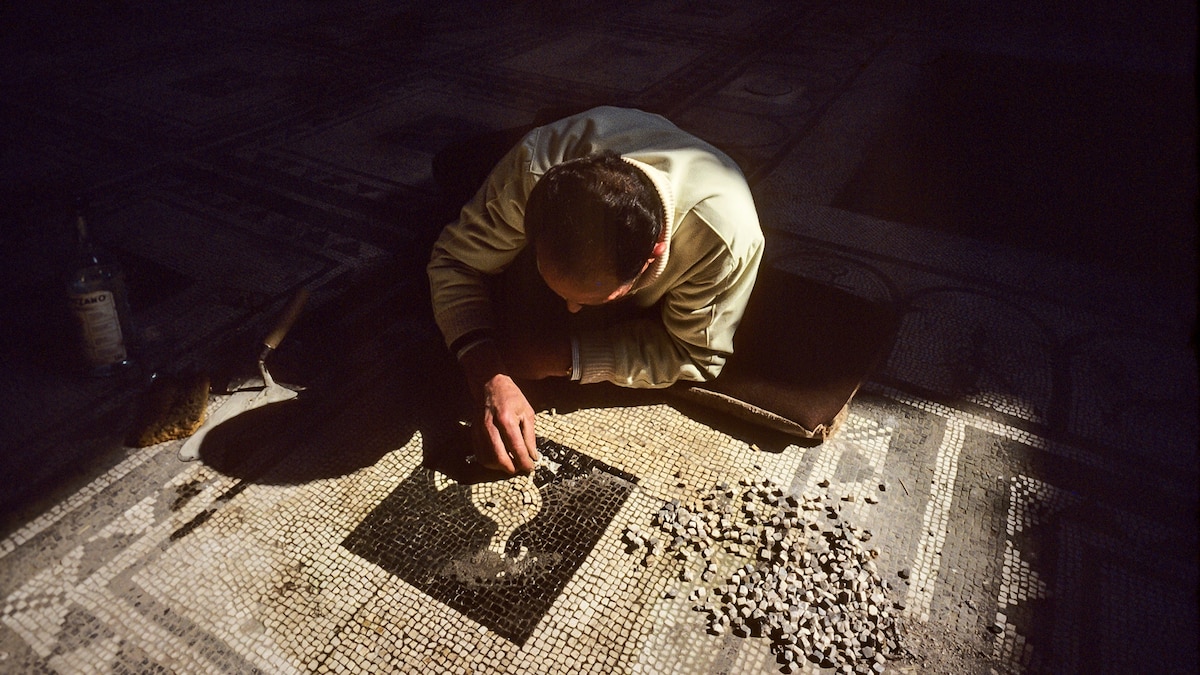Published September 25, 2023
7 min read
In the last year alone, excavations in the ancient Roman city of Pompeii have uncovered a 2,000-year-old laundromat, a bedroom used by slaves, and a fresco depicting an ancestor of pizza (minus the tomatoes—those wouldn’t come to Europe for at least another 10 centuries).
None of those discoveries, however, stemmed from new digs into the 20-foot layer of ash that encased the city after Mount Vesuvius’ eruption in A.D. 79. For decades, the Italian government had a moratorium on any new excavations in Pompeii. That means most of the finds are byproducts of efforts to preserve and restore what’s already been unearthed, according to Steven Ellis, a professor of Roman archaeology at the University of Cincinnati who worked on excavating Pompeii’s Porta Sabia neighborhood.
“When they dug [the city] out, they created a kind of cliff edge of that volcanic debris,” Ellis says, adding that landslides and cave-ins have occurred along previously excavated areas, causing international outcry. “So they’re restoring those and shoring those up, and to do that, they’ve had to excavate a bit of the edge.”
Pompeii, of course, still has more secrets to reveal. Estimates vary but anywhere between 15% to 25% of the city remains covered. For many archaeologists though, the question isn’t so much what they have left to find—but should they continue digging at all?
“We have enough of [excavated] Pompeii for the general public. We have enough of Pompeii for the scholarly community to learn from,” Ellis said. “What we really need to be doing is keeping it as well preserved for the future as we possibly can.”
Suburban farmland
Zoning didn’t exist in the ancient Roman city, and most of the businesses and retail areas clustered around the large streets, many of which have already been explored, according to Eric Poehler, a professor of classics at the University of Massachusetts-Amherst who has also assisted on the ground in Pompeii. Moving east, however, the population density and land-use decreases, and swathes of land there, especially the Southeast portion of the city, remain relatively untouched.
Rather than backyards with large gardens featuring topiary, statues, and columns, as seen in more populated and wealthy areas of the city, Poehler suspects the east might look more like farmland.
“We should expect something more like big backyards that might even be planted with agriculture for profit, rather than just for leisure,” he says.
Poehler also notes that archaeologists have overlooked a lot of information in previously excavated areas. Experts expect to find more pedestrian artifacts, paintings and graffiti, and victims of the volcanic eruption.
Going back over those unearthed areas with new and better technology could yield just as exciting discoveries as digging up new sites without putting the city—and future generations’ ability to see it—at risk, Ellis adds.
In the past, for example, any broken or incomplete frescos or pottery may have been thrown away. Now, AI robots are helping archaeologists piece them back together, and a type of LiDar can record spaces in three-dimensions, according to Ellis.
“We’d have photographs, but we’d never have enough,” he says. “Now we have these 3D-models, where we basically can return to almost any time of our excavation and see that space.”
Poehler, who helped create the Pompeii Bibliography and Mapping Project, also points to technologies that allow people to better visualize Pompeii. He’s currently working on the Pompeii Artistic Landscape Project, which will enable internet users to search for any item painted on a Pompeiian wall—from a proto-“pizza” to a Cupid—which he numbers at 87,075.
“What this new work is doing for us is it’s giving us a chance to revisit, now, 200 years worth of excavation history,” Ellis says. “We actually get to see [Pompeii] in better condition. We get to dig in in more interesting and more modern ways.”
Some of the city, however, has already been lost to time. In 2014, for example, days of heavy rain caused three collapses in just three days in Pompeii: a tomb, an arch in the Temple of Venus, and the wall of a workshop. Before that in 2010, the House of the Gladiators, or Schola Armarturarum, collapsed, likely due to restoration efforts in the ‘40s and ‘50s. The destruction of the building, one of the most celebrated in Pompeii, partially prompted UNESCO to threaten to take the city off its coveted World Heritage list. (Years later, the group decided to keep Pompeii’s status after significant restoration efforts.)
Excavations that may have contributed to those issues weren’t necessarily done improperly. Processes and technology just evolve as time passes, which contributes to the idea that archaeologists may want to decelerate their efforts a bit.
“There’s an opportunity cost to digging a lot today because tomorrow, we might have better skills, tools, information, technologies, and just physical abilities,” Poehler says. “And if we do it today, we rob ourselves of the opportunity in the future.”
‘Wonderment and surprise’
Italy has already launched several efforts to preserve and restore what’s already been unearthed in the city. The Great Pompeii Project, which began in 2012 as a joint effort with the European Union, spent $105 million euros to secure embankments, restore walls, and protect structures from weather exposure, among other goals. The project wrapped up in December 2019, but how to attract tourists with new discoveries while also protecting the city remains a point of friction in Italian politics.
The discoveries made during the restoration project, however, proved just as attention-grabbing. Work to improve the stability of Region V (Pompeii has nine regions total) in 2018 revealed frescos, including one near the House of the Silver Wedding, a majestic example of how the aristocracy lived, that features a pair of dolphins.
Later that year, archaeologists uncovered what they dubbed the “Enchanted Garden,” a lavishly decorated lararium, or the portion of the house set aside as a shrine to the gods, that depicted a man with a dog’s head, potentially a nod to Egyptian god Anubis.
“One of the things that we can look forward to every time that we think about excavating Pompeii or just peering below its ground level is wonderment and surprise,” Poehler says. “We will find absolutely gorgeous pieces and glimpses of the past with every shovelful that comes out.”





